University Nursing Course: Leadership and Professionalism
VerifiedAdded on 2022/10/11
|12
|3524
|38
Essay
AI Summary
This nursing essay delves into the critical aspects of leadership and professionalism within the healthcare sector. It highlights the significance of emotional intelligence, encompassing self-awareness, self-management, relationship management, and social awareness, as vital skills for registered nurses (RNs) to effectively manage patient care and collaborate within healthcare teams. The essay also emphasizes the importance of professionalism, including attitudinal, psychomotor, and cognitive components, as a cornerstone for delivering high-quality patient care and fostering a positive work environment. Furthermore, it discusses the importance of self-awareness and relationship management. It then addresses the role of communication and health informatics in rehabilitation services, including patient privacy and safety challenges, and suggests digital innovations like huggable robots to enhance patient-centered care. The essay also explores role ambiguity and its impact on job satisfaction and patient care, and concludes with self-care strategies for nurses to maintain their well-being. This essay is a valuable resource for nursing students and professionals seeking to understand and enhance their leadership capabilities and overall practice.
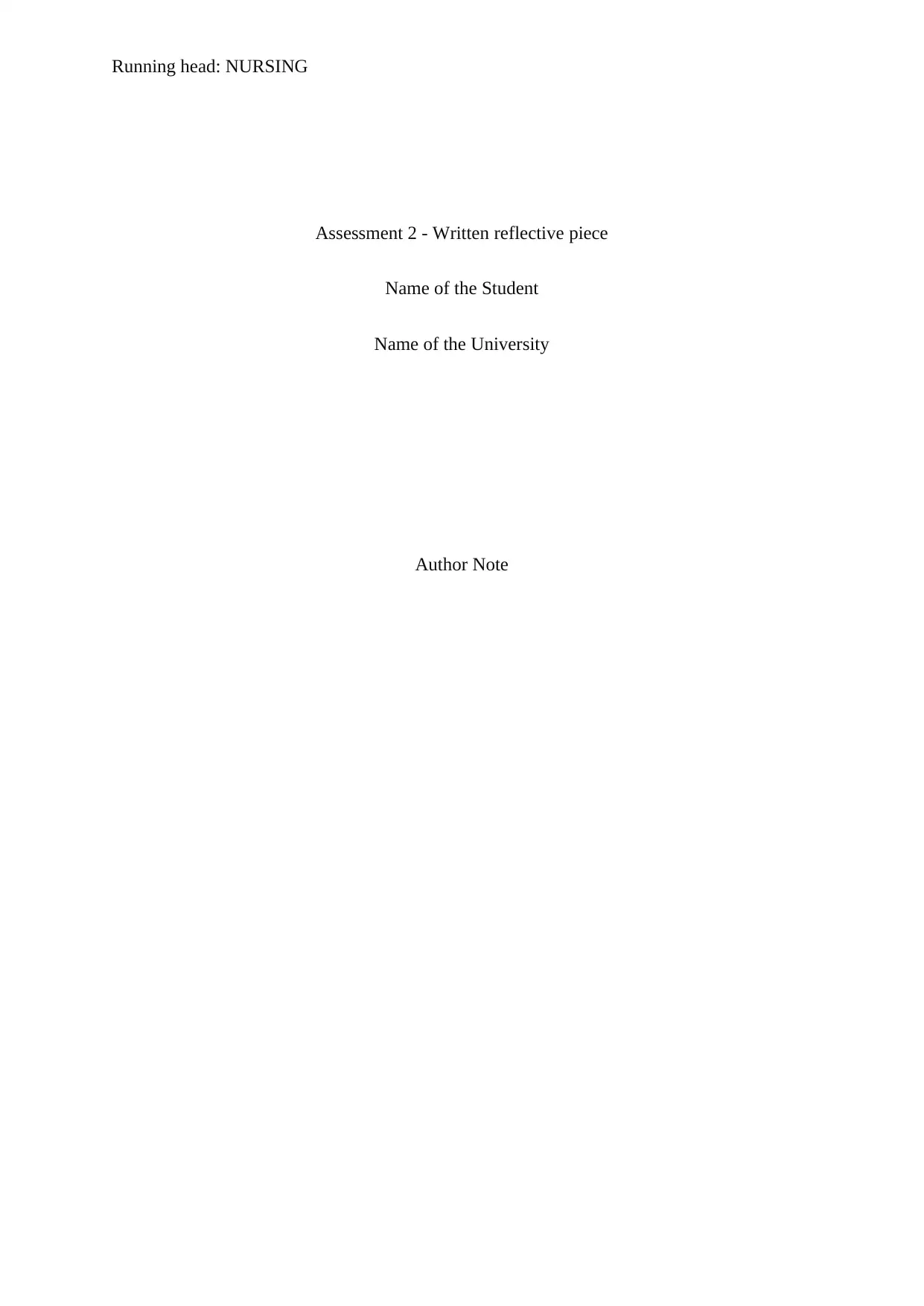
Running head: NURSING
Assessment 2 - Written reflective piece
Name of the Student
Name of the University
Author Note
Assessment 2 - Written reflective piece
Name of the Student
Name of the University
Author Note
Paraphrase This Document
Need a fresh take? Get an instant paraphrase of this document with our AI Paraphraser
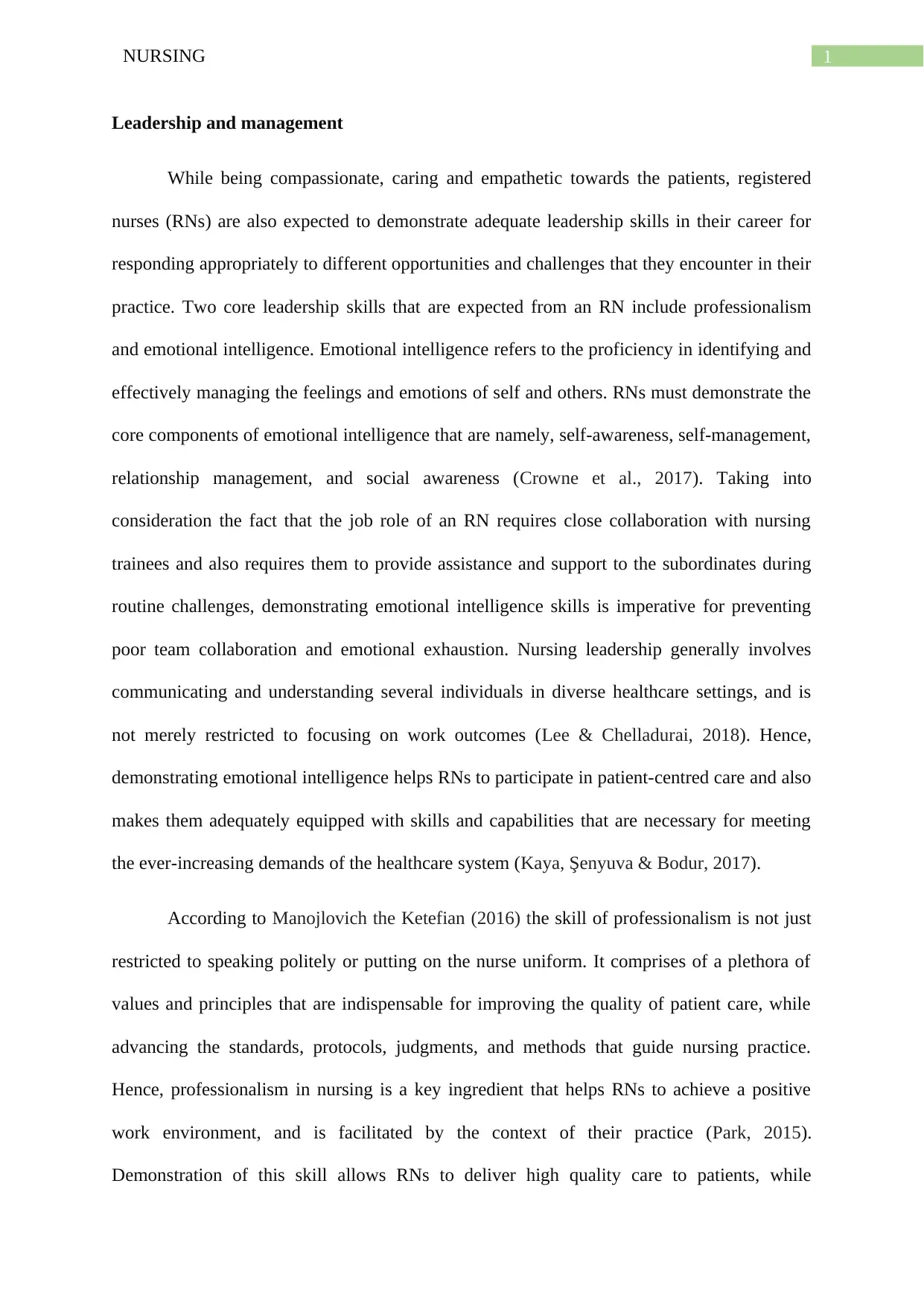
1NURSING
Leadership and management
While being compassionate, caring and empathetic towards the patients, registered
nurses (RNs) are also expected to demonstrate adequate leadership skills in their career for
responding appropriately to different opportunities and challenges that they encounter in their
practice. Two core leadership skills that are expected from an RN include professionalism
and emotional intelligence. Emotional intelligence refers to the proficiency in identifying and
effectively managing the feelings and emotions of self and others. RNs must demonstrate the
core components of emotional intelligence that are namely, self-awareness, self-management,
relationship management, and social awareness (Crowne et al., 2017). Taking into
consideration the fact that the job role of an RN requires close collaboration with nursing
trainees and also requires them to provide assistance and support to the subordinates during
routine challenges, demonstrating emotional intelligence skills is imperative for preventing
poor team collaboration and emotional exhaustion. Nursing leadership generally involves
communicating and understanding several individuals in diverse healthcare settings, and is
not merely restricted to focusing on work outcomes (Lee & Chelladurai, 2018). Hence,
demonstrating emotional intelligence helps RNs to participate in patient-centred care and also
makes them adequately equipped with skills and capabilities that are necessary for meeting
the ever-increasing demands of the healthcare system (Kaya, Şenyuva & Bodur, 2017).
According to Manojlovich the Ketefian (2016) the skill of professionalism is not just
restricted to speaking politely or putting on the nurse uniform. It comprises of a plethora of
values and principles that are indispensable for improving the quality of patient care, while
advancing the standards, protocols, judgments, and methods that guide nursing practice.
Hence, professionalism in nursing is a key ingredient that helps RNs to achieve a positive
work environment, and is facilitated by the context of their practice (Park, 2015).
Demonstration of this skill allows RNs to deliver high quality care to patients, while
Leadership and management
While being compassionate, caring and empathetic towards the patients, registered
nurses (RNs) are also expected to demonstrate adequate leadership skills in their career for
responding appropriately to different opportunities and challenges that they encounter in their
practice. Two core leadership skills that are expected from an RN include professionalism
and emotional intelligence. Emotional intelligence refers to the proficiency in identifying and
effectively managing the feelings and emotions of self and others. RNs must demonstrate the
core components of emotional intelligence that are namely, self-awareness, self-management,
relationship management, and social awareness (Crowne et al., 2017). Taking into
consideration the fact that the job role of an RN requires close collaboration with nursing
trainees and also requires them to provide assistance and support to the subordinates during
routine challenges, demonstrating emotional intelligence skills is imperative for preventing
poor team collaboration and emotional exhaustion. Nursing leadership generally involves
communicating and understanding several individuals in diverse healthcare settings, and is
not merely restricted to focusing on work outcomes (Lee & Chelladurai, 2018). Hence,
demonstrating emotional intelligence helps RNs to participate in patient-centred care and also
makes them adequately equipped with skills and capabilities that are necessary for meeting
the ever-increasing demands of the healthcare system (Kaya, Şenyuva & Bodur, 2017).
According to Manojlovich the Ketefian (2016) the skill of professionalism is not just
restricted to speaking politely or putting on the nurse uniform. It comprises of a plethora of
values and principles that are indispensable for improving the quality of patient care, while
advancing the standards, protocols, judgments, and methods that guide nursing practice.
Hence, professionalism in nursing is a key ingredient that helps RNs to achieve a positive
work environment, and is facilitated by the context of their practice (Park, 2015).
Demonstration of this skill allows RNs to deliver high quality care to patients, while
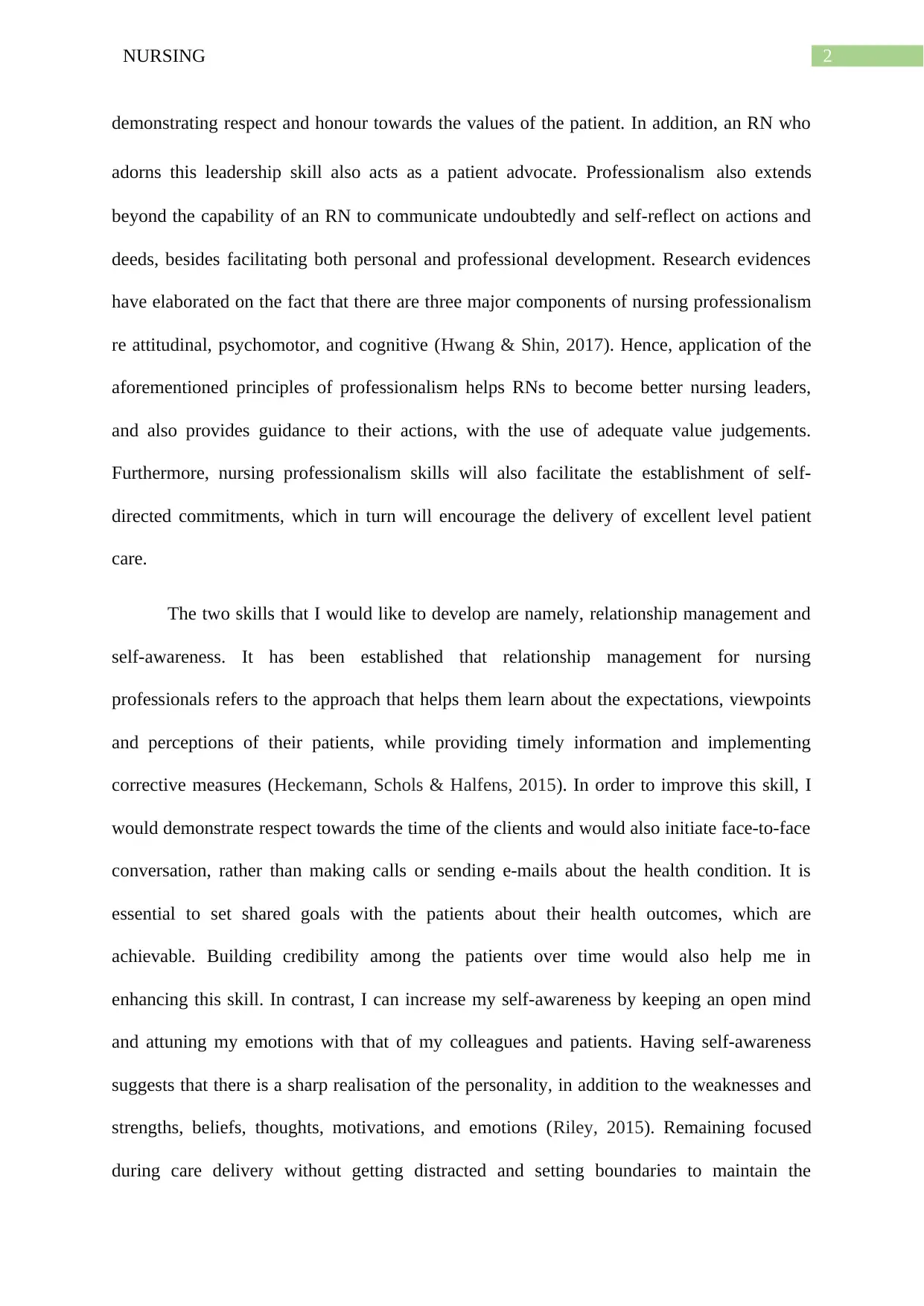
2NURSING
demonstrating respect and honour towards the values of the patient. In addition, an RN who
adorns this leadership skill also acts as a patient advocate. Professionalism also extends
beyond the capability of an RN to communicate undoubtedly and self-reflect on actions and
deeds, besides facilitating both personal and professional development. Research evidences
have elaborated on the fact that there are three major components of nursing professionalism
re attitudinal, psychomotor, and cognitive (Hwang & Shin, 2017). Hence, application of the
aforementioned principles of professionalism helps RNs to become better nursing leaders,
and also provides guidance to their actions, with the use of adequate value judgements.
Furthermore, nursing professionalism skills will also facilitate the establishment of self-
directed commitments, which in turn will encourage the delivery of excellent level patient
care.
The two skills that I would like to develop are namely, relationship management and
self-awareness. It has been established that relationship management for nursing
professionals refers to the approach that helps them learn about the expectations, viewpoints
and perceptions of their patients, while providing timely information and implementing
corrective measures (Heckemann, Schols & Halfens, 2015). In order to improve this skill, I
would demonstrate respect towards the time of the clients and would also initiate face-to-face
conversation, rather than making calls or sending e-mails about the health condition. It is
essential to set shared goals with the patients about their health outcomes, which are
achievable. Building credibility among the patients over time would also help me in
enhancing this skill. In contrast, I can increase my self-awareness by keeping an open mind
and attuning my emotions with that of my colleagues and patients. Having self-awareness
suggests that there is a sharp realisation of the personality, in addition to the weaknesses and
strengths, beliefs, thoughts, motivations, and emotions (Riley, 2015). Remaining focused
during care delivery without getting distracted and setting boundaries to maintain the
demonstrating respect and honour towards the values of the patient. In addition, an RN who
adorns this leadership skill also acts as a patient advocate. Professionalism also extends
beyond the capability of an RN to communicate undoubtedly and self-reflect on actions and
deeds, besides facilitating both personal and professional development. Research evidences
have elaborated on the fact that there are three major components of nursing professionalism
re attitudinal, psychomotor, and cognitive (Hwang & Shin, 2017). Hence, application of the
aforementioned principles of professionalism helps RNs to become better nursing leaders,
and also provides guidance to their actions, with the use of adequate value judgements.
Furthermore, nursing professionalism skills will also facilitate the establishment of self-
directed commitments, which in turn will encourage the delivery of excellent level patient
care.
The two skills that I would like to develop are namely, relationship management and
self-awareness. It has been established that relationship management for nursing
professionals refers to the approach that helps them learn about the expectations, viewpoints
and perceptions of their patients, while providing timely information and implementing
corrective measures (Heckemann, Schols & Halfens, 2015). In order to improve this skill, I
would demonstrate respect towards the time of the clients and would also initiate face-to-face
conversation, rather than making calls or sending e-mails about the health condition. It is
essential to set shared goals with the patients about their health outcomes, which are
achievable. Building credibility among the patients over time would also help me in
enhancing this skill. In contrast, I can increase my self-awareness by keeping an open mind
and attuning my emotions with that of my colleagues and patients. Having self-awareness
suggests that there is a sharp realisation of the personality, in addition to the weaknesses and
strengths, beliefs, thoughts, motivations, and emotions (Riley, 2015). Remaining focused
during care delivery without getting distracted and setting boundaries to maintain the
⊘ This is a preview!⊘
Do you want full access?
Subscribe today to unlock all pages.

Trusted by 1+ million students worldwide
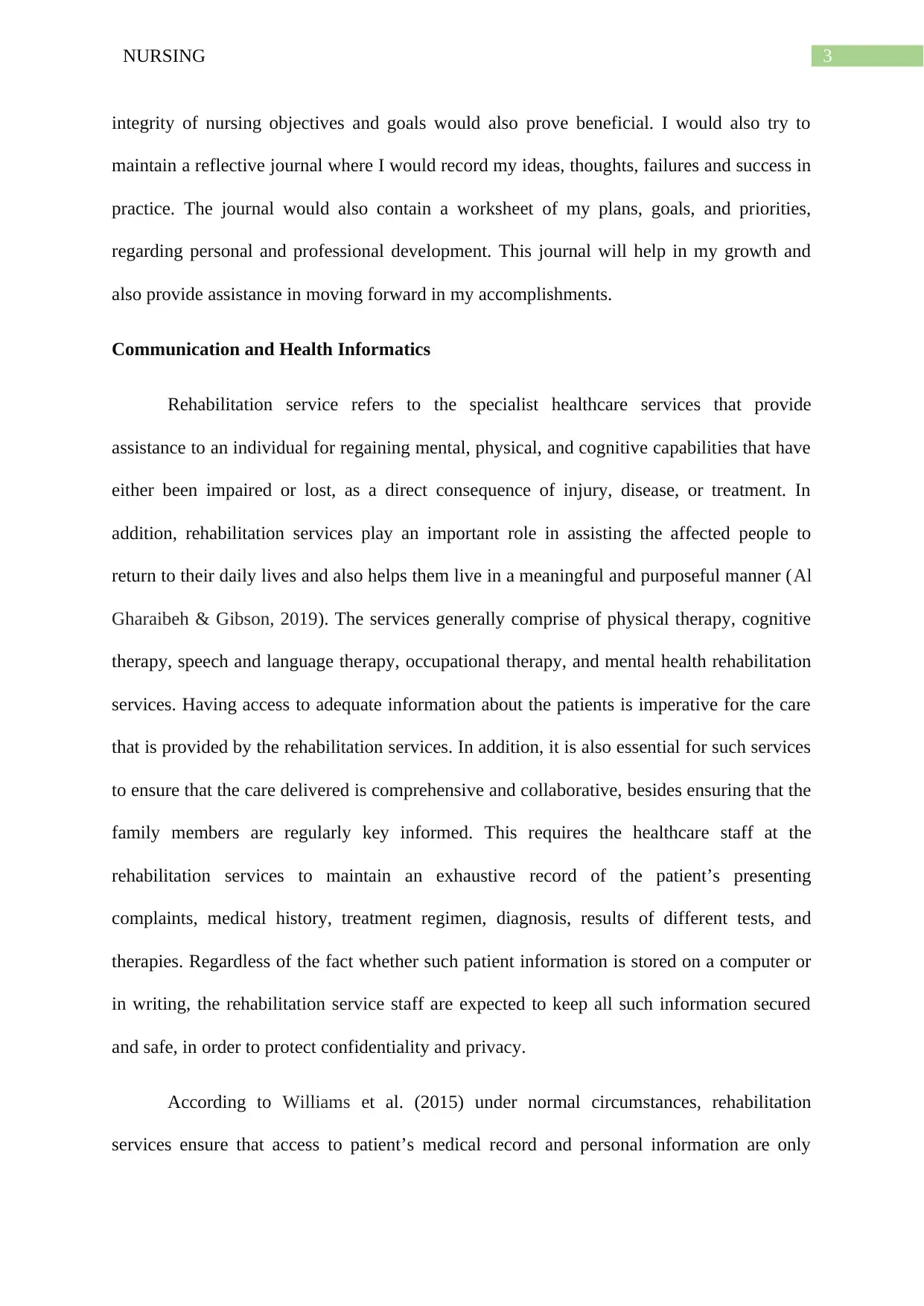
3NURSING
integrity of nursing objectives and goals would also prove beneficial. I would also try to
maintain a reflective journal where I would record my ideas, thoughts, failures and success in
practice. The journal would also contain a worksheet of my plans, goals, and priorities,
regarding personal and professional development. This journal will help in my growth and
also provide assistance in moving forward in my accomplishments.
Communication and Health Informatics
Rehabilitation service refers to the specialist healthcare services that provide
assistance to an individual for regaining mental, physical, and cognitive capabilities that have
either been impaired or lost, as a direct consequence of injury, disease, or treatment. In
addition, rehabilitation services play an important role in assisting the affected people to
return to their daily lives and also helps them live in a meaningful and purposeful manner (Al
Gharaibeh & Gibson, 2019). The services generally comprise of physical therapy, cognitive
therapy, speech and language therapy, occupational therapy, and mental health rehabilitation
services. Having access to adequate information about the patients is imperative for the care
that is provided by the rehabilitation services. In addition, it is also essential for such services
to ensure that the care delivered is comprehensive and collaborative, besides ensuring that the
family members are regularly key informed. This requires the healthcare staff at the
rehabilitation services to maintain an exhaustive record of the patient’s presenting
complaints, medical history, treatment regimen, diagnosis, results of different tests, and
therapies. Regardless of the fact whether such patient information is stored on a computer or
in writing, the rehabilitation service staff are expected to keep all such information secured
and safe, in order to protect confidentiality and privacy.
According to Williams et al. (2015) under normal circumstances, rehabilitation
services ensure that access to patient’s medical record and personal information are only
integrity of nursing objectives and goals would also prove beneficial. I would also try to
maintain a reflective journal where I would record my ideas, thoughts, failures and success in
practice. The journal would also contain a worksheet of my plans, goals, and priorities,
regarding personal and professional development. This journal will help in my growth and
also provide assistance in moving forward in my accomplishments.
Communication and Health Informatics
Rehabilitation service refers to the specialist healthcare services that provide
assistance to an individual for regaining mental, physical, and cognitive capabilities that have
either been impaired or lost, as a direct consequence of injury, disease, or treatment. In
addition, rehabilitation services play an important role in assisting the affected people to
return to their daily lives and also helps them live in a meaningful and purposeful manner (Al
Gharaibeh & Gibson, 2019). The services generally comprise of physical therapy, cognitive
therapy, speech and language therapy, occupational therapy, and mental health rehabilitation
services. Having access to adequate information about the patients is imperative for the care
that is provided by the rehabilitation services. In addition, it is also essential for such services
to ensure that the care delivered is comprehensive and collaborative, besides ensuring that the
family members are regularly key informed. This requires the healthcare staff at the
rehabilitation services to maintain an exhaustive record of the patient’s presenting
complaints, medical history, treatment regimen, diagnosis, results of different tests, and
therapies. Regardless of the fact whether such patient information is stored on a computer or
in writing, the rehabilitation service staff are expected to keep all such information secured
and safe, in order to protect confidentiality and privacy.
According to Williams et al. (2015) under normal circumstances, rehabilitation
services ensure that access to patient’s medical record and personal information are only
Paraphrase This Document
Need a fresh take? Get an instant paraphrase of this document with our AI Paraphraser
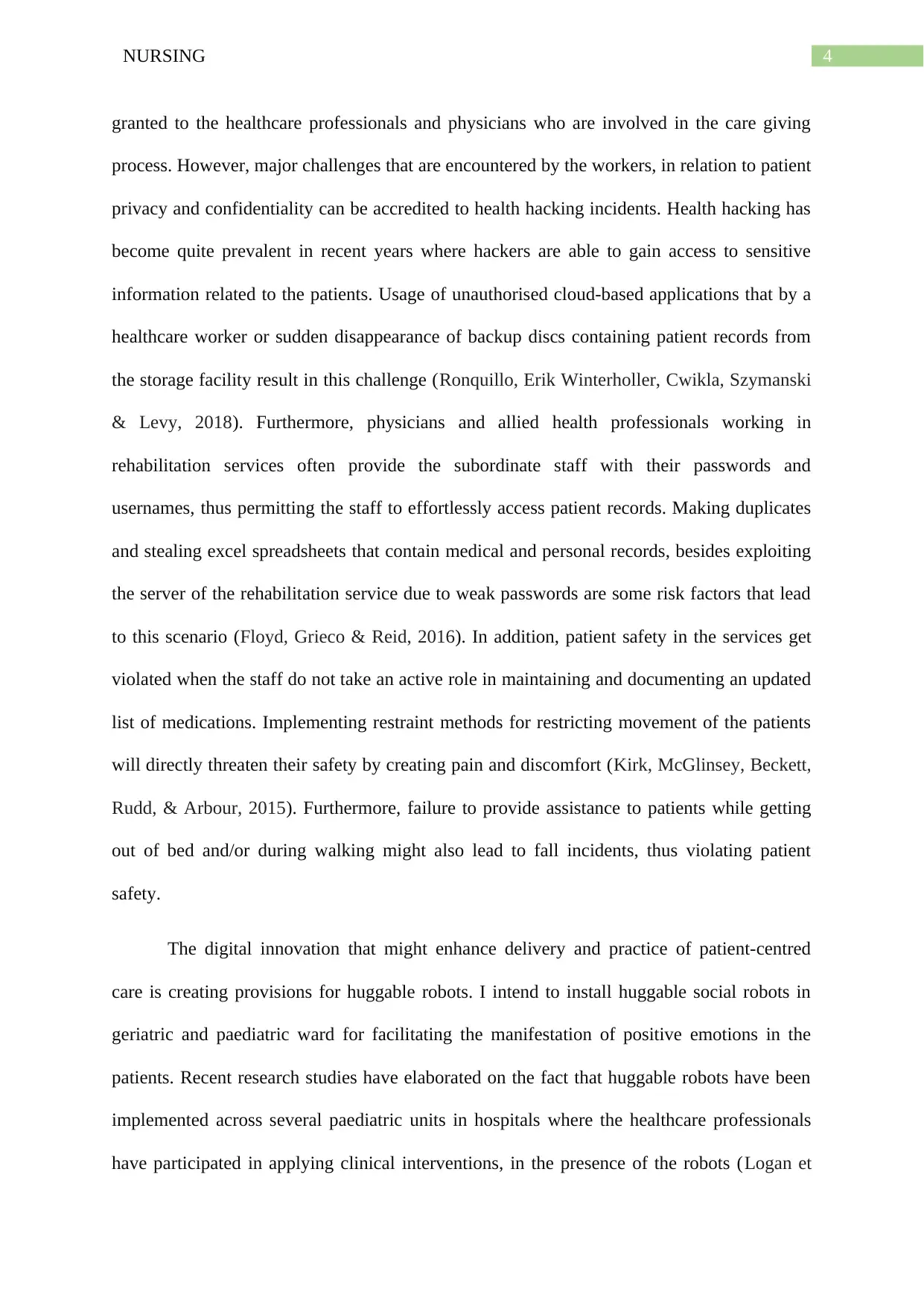
4NURSING
granted to the healthcare professionals and physicians who are involved in the care giving
process. However, major challenges that are encountered by the workers, in relation to patient
privacy and confidentiality can be accredited to health hacking incidents. Health hacking has
become quite prevalent in recent years where hackers are able to gain access to sensitive
information related to the patients. Usage of unauthorised cloud-based applications that by a
healthcare worker or sudden disappearance of backup discs containing patient records from
the storage facility result in this challenge (Ronquillo, Erik Winterholler, Cwikla, Szymanski
& Levy, 2018). Furthermore, physicians and allied health professionals working in
rehabilitation services often provide the subordinate staff with their passwords and
usernames, thus permitting the staff to effortlessly access patient records. Making duplicates
and stealing excel spreadsheets that contain medical and personal records, besides exploiting
the server of the rehabilitation service due to weak passwords are some risk factors that lead
to this scenario (Floyd, Grieco & Reid, 2016). In addition, patient safety in the services get
violated when the staff do not take an active role in maintaining and documenting an updated
list of medications. Implementing restraint methods for restricting movement of the patients
will directly threaten their safety by creating pain and discomfort (Kirk, McGlinsey, Beckett,
Rudd, & Arbour, 2015). Furthermore, failure to provide assistance to patients while getting
out of bed and/or during walking might also lead to fall incidents, thus violating patient
safety.
The digital innovation that might enhance delivery and practice of patient-centred
care is creating provisions for huggable robots. I intend to install huggable social robots in
geriatric and paediatric ward for facilitating the manifestation of positive emotions in the
patients. Recent research studies have elaborated on the fact that huggable robots have been
implemented across several paediatric units in hospitals where the healthcare professionals
have participated in applying clinical interventions, in the presence of the robots (Logan et
granted to the healthcare professionals and physicians who are involved in the care giving
process. However, major challenges that are encountered by the workers, in relation to patient
privacy and confidentiality can be accredited to health hacking incidents. Health hacking has
become quite prevalent in recent years where hackers are able to gain access to sensitive
information related to the patients. Usage of unauthorised cloud-based applications that by a
healthcare worker or sudden disappearance of backup discs containing patient records from
the storage facility result in this challenge (Ronquillo, Erik Winterholler, Cwikla, Szymanski
& Levy, 2018). Furthermore, physicians and allied health professionals working in
rehabilitation services often provide the subordinate staff with their passwords and
usernames, thus permitting the staff to effortlessly access patient records. Making duplicates
and stealing excel spreadsheets that contain medical and personal records, besides exploiting
the server of the rehabilitation service due to weak passwords are some risk factors that lead
to this scenario (Floyd, Grieco & Reid, 2016). In addition, patient safety in the services get
violated when the staff do not take an active role in maintaining and documenting an updated
list of medications. Implementing restraint methods for restricting movement of the patients
will directly threaten their safety by creating pain and discomfort (Kirk, McGlinsey, Beckett,
Rudd, & Arbour, 2015). Furthermore, failure to provide assistance to patients while getting
out of bed and/or during walking might also lead to fall incidents, thus violating patient
safety.
The digital innovation that might enhance delivery and practice of patient-centred
care is creating provisions for huggable robots. I intend to install huggable social robots in
geriatric and paediatric ward for facilitating the manifestation of positive emotions in the
patients. Recent research studies have elaborated on the fact that huggable robots have been
implemented across several paediatric units in hospitals where the healthcare professionals
have participated in applying clinical interventions, in the presence of the robots (Logan et
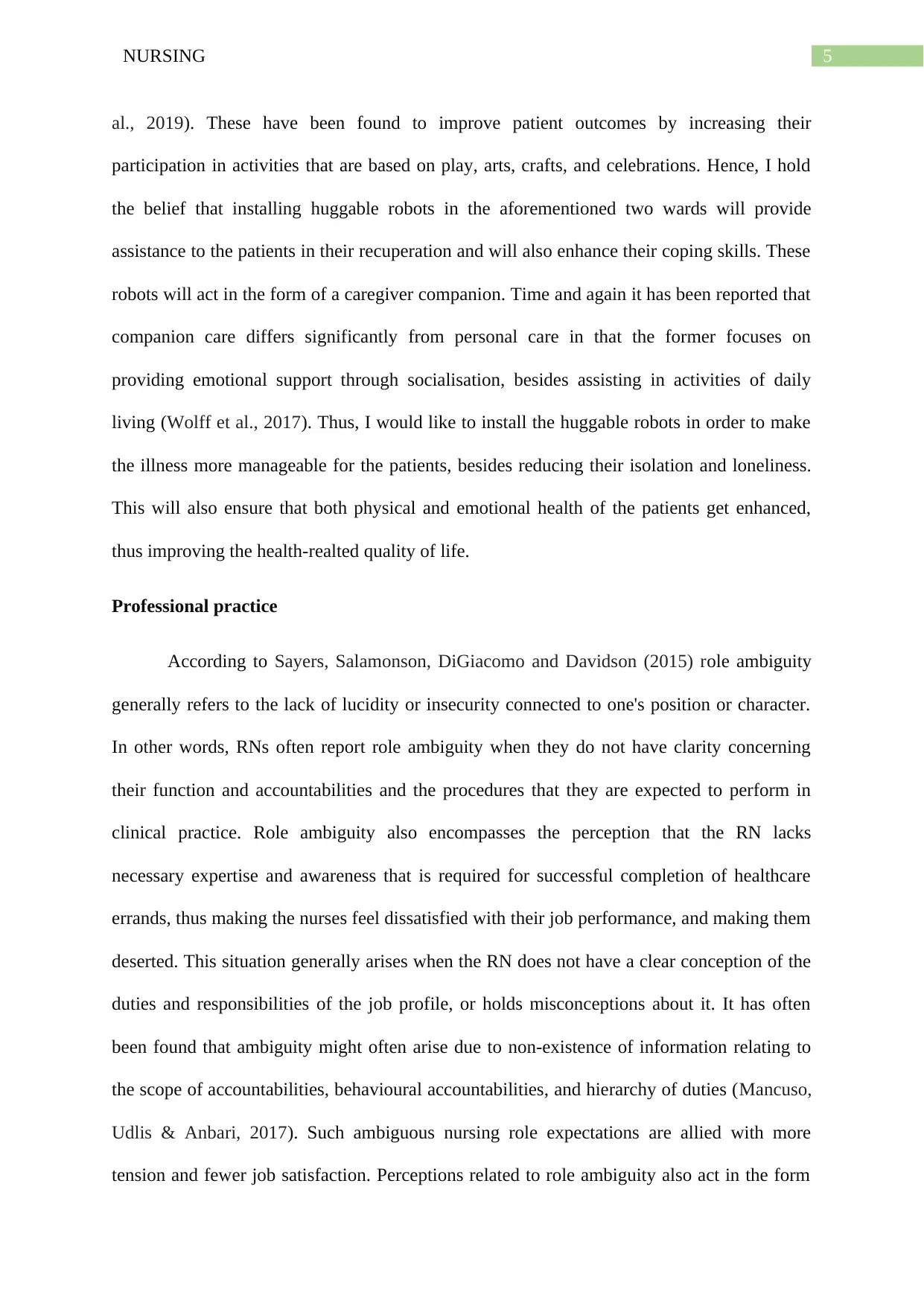
5NURSING
al., 2019). These have been found to improve patient outcomes by increasing their
participation in activities that are based on play, arts, crafts, and celebrations. Hence, I hold
the belief that installing huggable robots in the aforementioned two wards will provide
assistance to the patients in their recuperation and will also enhance their coping skills. These
robots will act in the form of a caregiver companion. Time and again it has been reported that
companion care differs significantly from personal care in that the former focuses on
providing emotional support through socialisation, besides assisting in activities of daily
living (Wolff et al., 2017). Thus, I would like to install the huggable robots in order to make
the illness more manageable for the patients, besides reducing their isolation and loneliness.
This will also ensure that both physical and emotional health of the patients get enhanced,
thus improving the health-realted quality of life.
Professional practice
According to Sayers, Salamonson, DiGiacomo and Davidson (2015) role ambiguity
generally refers to the lack of lucidity or insecurity connected to one's position or character.
In other words, RNs often report role ambiguity when they do not have clarity concerning
their function and accountabilities and the procedures that they are expected to perform in
clinical practice. Role ambiguity also encompasses the perception that the RN lacks
necessary expertise and awareness that is required for successful completion of healthcare
errands, thus making the nurses feel dissatisfied with their job performance, and making them
deserted. This situation generally arises when the RN does not have a clear conception of the
duties and responsibilities of the job profile, or holds misconceptions about it. It has often
been found that ambiguity might often arise due to non-existence of information relating to
the scope of accountabilities, behavioural accountabilities, and hierarchy of duties (Mancuso,
Udlis & Anbari, 2017). Such ambiguous nursing role expectations are allied with more
tension and fewer job satisfaction. Perceptions related to role ambiguity also act in the form
al., 2019). These have been found to improve patient outcomes by increasing their
participation in activities that are based on play, arts, crafts, and celebrations. Hence, I hold
the belief that installing huggable robots in the aforementioned two wards will provide
assistance to the patients in their recuperation and will also enhance their coping skills. These
robots will act in the form of a caregiver companion. Time and again it has been reported that
companion care differs significantly from personal care in that the former focuses on
providing emotional support through socialisation, besides assisting in activities of daily
living (Wolff et al., 2017). Thus, I would like to install the huggable robots in order to make
the illness more manageable for the patients, besides reducing their isolation and loneliness.
This will also ensure that both physical and emotional health of the patients get enhanced,
thus improving the health-realted quality of life.
Professional practice
According to Sayers, Salamonson, DiGiacomo and Davidson (2015) role ambiguity
generally refers to the lack of lucidity or insecurity connected to one's position or character.
In other words, RNs often report role ambiguity when they do not have clarity concerning
their function and accountabilities and the procedures that they are expected to perform in
clinical practice. Role ambiguity also encompasses the perception that the RN lacks
necessary expertise and awareness that is required for successful completion of healthcare
errands, thus making the nurses feel dissatisfied with their job performance, and making them
deserted. This situation generally arises when the RN does not have a clear conception of the
duties and responsibilities of the job profile, or holds misconceptions about it. It has often
been found that ambiguity might often arise due to non-existence of information relating to
the scope of accountabilities, behavioural accountabilities, and hierarchy of duties (Mancuso,
Udlis & Anbari, 2017). Such ambiguous nursing role expectations are allied with more
tension and fewer job satisfaction. Perceptions related to role ambiguity also act in the form
⊘ This is a preview!⊘
Do you want full access?
Subscribe today to unlock all pages.

Trusted by 1+ million students worldwide
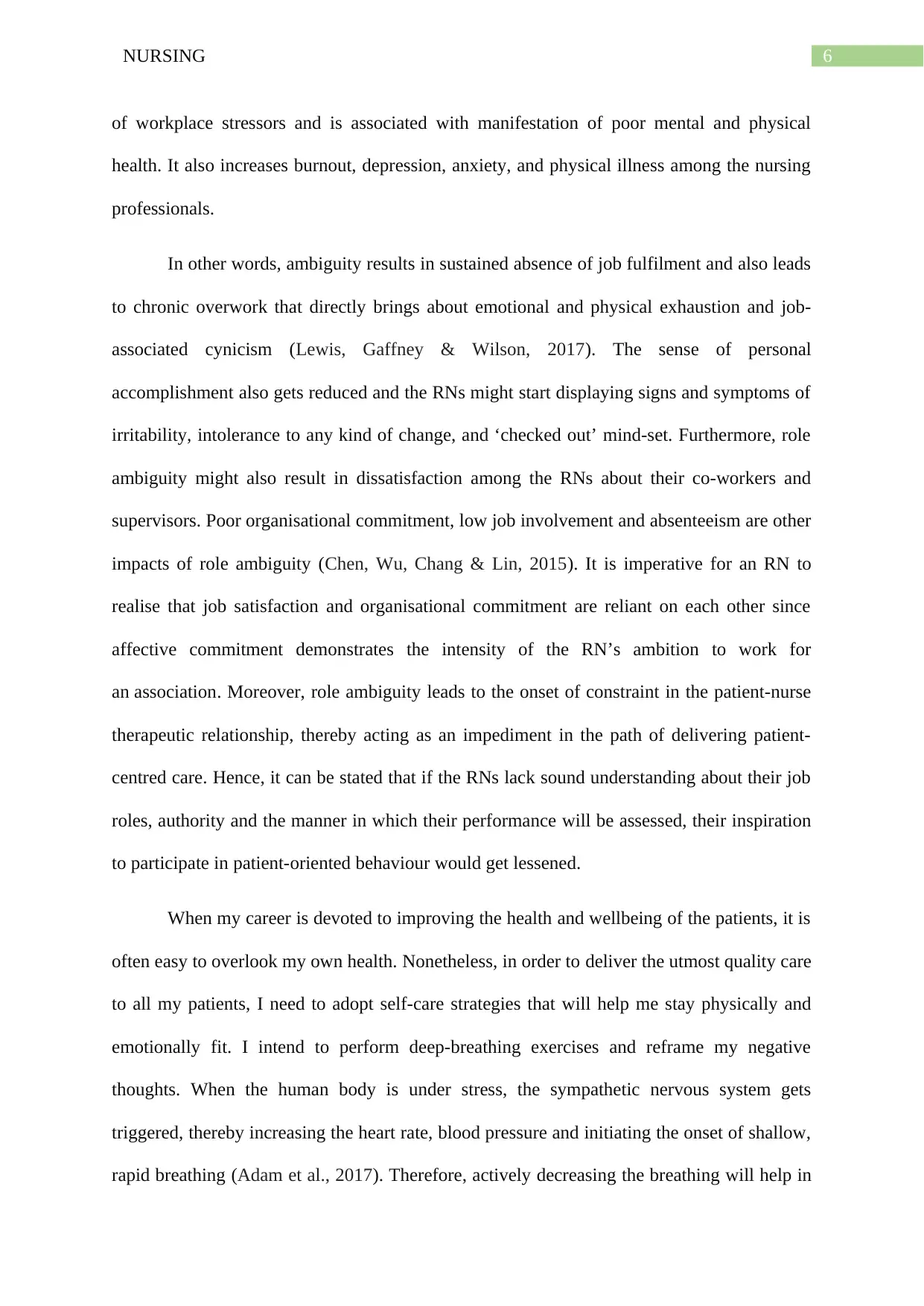
6NURSING
of workplace stressors and is associated with manifestation of poor mental and physical
health. It also increases burnout, depression, anxiety, and physical illness among the nursing
professionals.
In other words, ambiguity results in sustained absence of job fulfilment and also leads
to chronic overwork that directly brings about emotional and physical exhaustion and job-
associated cynicism (Lewis, Gaffney & Wilson, 2017). The sense of personal
accomplishment also gets reduced and the RNs might start displaying signs and symptoms of
irritability, intolerance to any kind of change, and ‘checked out’ mind-set. Furthermore, role
ambiguity might also result in dissatisfaction among the RNs about their co-workers and
supervisors. Poor organisational commitment, low job involvement and absenteeism are other
impacts of role ambiguity (Chen, Wu, Chang & Lin, 2015). It is imperative for an RN to
realise that job satisfaction and organisational commitment are reliant on each other since
affective commitment demonstrates the intensity of the RN’s ambition to work for
an association. Moreover, role ambiguity leads to the onset of constraint in the patient-nurse
therapeutic relationship, thereby acting as an impediment in the path of delivering patient-
centred care. Hence, it can be stated that if the RNs lack sound understanding about their job
roles, authority and the manner in which their performance will be assessed, their inspiration
to participate in patient-oriented behaviour would get lessened.
When my career is devoted to improving the health and wellbeing of the patients, it is
often easy to overlook my own health. Nonetheless, in order to deliver the utmost quality care
to all my patients, I need to adopt self-care strategies that will help me stay physically and
emotionally fit. I intend to perform deep-breathing exercises and reframe my negative
thoughts. When the human body is under stress, the sympathetic nervous system gets
triggered, thereby increasing the heart rate, blood pressure and initiating the onset of shallow,
rapid breathing (Adam et al., 2017). Therefore, actively decreasing the breathing will help in
of workplace stressors and is associated with manifestation of poor mental and physical
health. It also increases burnout, depression, anxiety, and physical illness among the nursing
professionals.
In other words, ambiguity results in sustained absence of job fulfilment and also leads
to chronic overwork that directly brings about emotional and physical exhaustion and job-
associated cynicism (Lewis, Gaffney & Wilson, 2017). The sense of personal
accomplishment also gets reduced and the RNs might start displaying signs and symptoms of
irritability, intolerance to any kind of change, and ‘checked out’ mind-set. Furthermore, role
ambiguity might also result in dissatisfaction among the RNs about their co-workers and
supervisors. Poor organisational commitment, low job involvement and absenteeism are other
impacts of role ambiguity (Chen, Wu, Chang & Lin, 2015). It is imperative for an RN to
realise that job satisfaction and organisational commitment are reliant on each other since
affective commitment demonstrates the intensity of the RN’s ambition to work for
an association. Moreover, role ambiguity leads to the onset of constraint in the patient-nurse
therapeutic relationship, thereby acting as an impediment in the path of delivering patient-
centred care. Hence, it can be stated that if the RNs lack sound understanding about their job
roles, authority and the manner in which their performance will be assessed, their inspiration
to participate in patient-oriented behaviour would get lessened.
When my career is devoted to improving the health and wellbeing of the patients, it is
often easy to overlook my own health. Nonetheless, in order to deliver the utmost quality care
to all my patients, I need to adopt self-care strategies that will help me stay physically and
emotionally fit. I intend to perform deep-breathing exercises and reframe my negative
thoughts. When the human body is under stress, the sympathetic nervous system gets
triggered, thereby increasing the heart rate, blood pressure and initiating the onset of shallow,
rapid breathing (Adam et al., 2017). Therefore, actively decreasing the breathing will help in
Paraphrase This Document
Need a fresh take? Get an instant paraphrase of this document with our AI Paraphraser
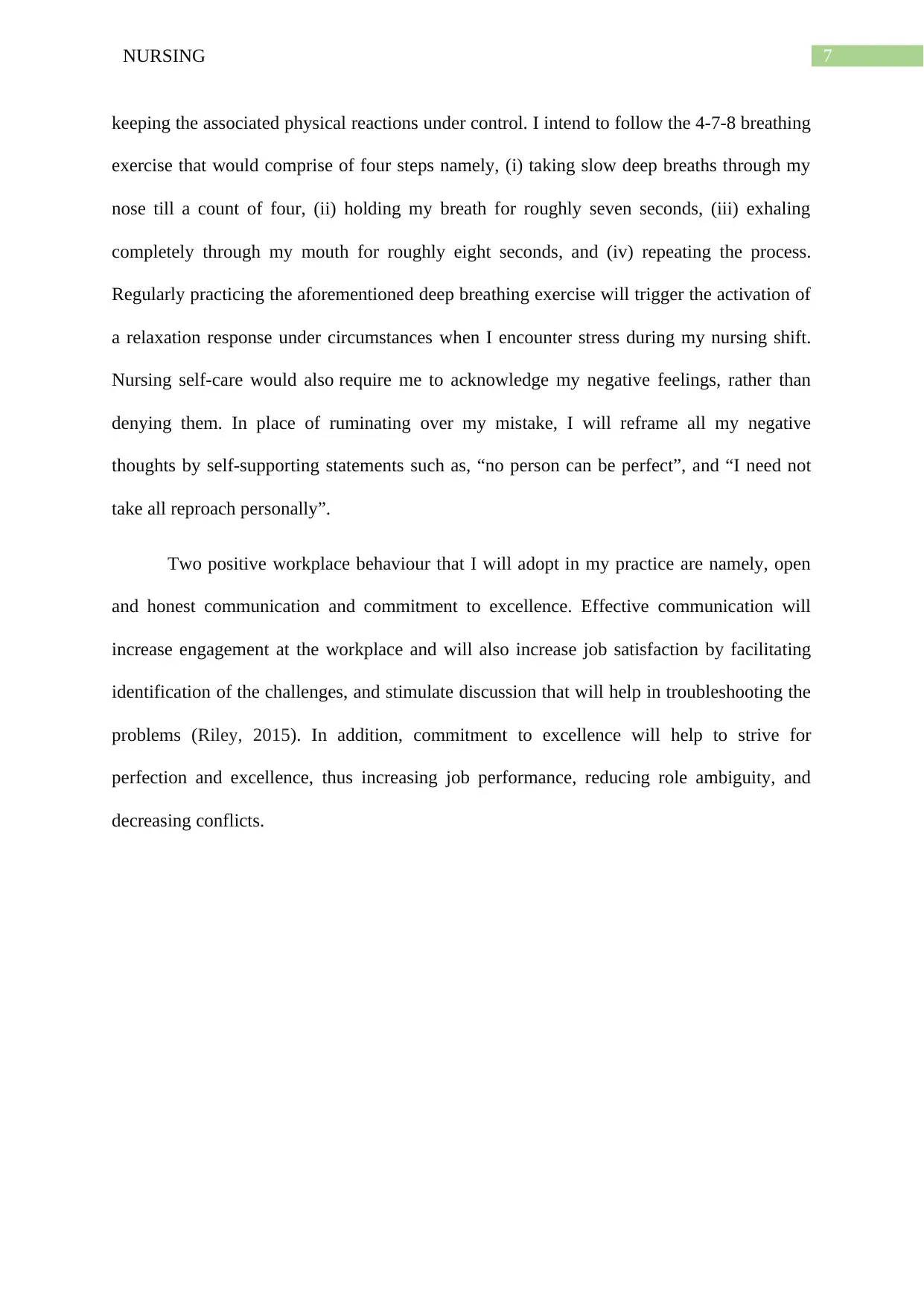
7NURSING
keeping the associated physical reactions under control. I intend to follow the 4-7-8 breathing
exercise that would comprise of four steps namely, (i) taking slow deep breaths through my
nose till a count of four, (ii) holding my breath for roughly seven seconds, (iii) exhaling
completely through my mouth for roughly eight seconds, and (iv) repeating the process.
Regularly practicing the aforementioned deep breathing exercise will trigger the activation of
a relaxation response under circumstances when I encounter stress during my nursing shift.
Nursing self-care would also require me to acknowledge my negative feelings, rather than
denying them. In place of ruminating over my mistake, I will reframe all my negative
thoughts by self-supporting statements such as, “no person can be perfect”, and “I need not
take all reproach personally”.
Two positive workplace behaviour that I will adopt in my practice are namely, open
and honest communication and commitment to excellence. Effective communication will
increase engagement at the workplace and will also increase job satisfaction by facilitating
identification of the challenges, and stimulate discussion that will help in troubleshooting the
problems (Riley, 2015). In addition, commitment to excellence will help to strive for
perfection and excellence, thus increasing job performance, reducing role ambiguity, and
decreasing conflicts.
keeping the associated physical reactions under control. I intend to follow the 4-7-8 breathing
exercise that would comprise of four steps namely, (i) taking slow deep breaths through my
nose till a count of four, (ii) holding my breath for roughly seven seconds, (iii) exhaling
completely through my mouth for roughly eight seconds, and (iv) repeating the process.
Regularly practicing the aforementioned deep breathing exercise will trigger the activation of
a relaxation response under circumstances when I encounter stress during my nursing shift.
Nursing self-care would also require me to acknowledge my negative feelings, rather than
denying them. In place of ruminating over my mistake, I will reframe all my negative
thoughts by self-supporting statements such as, “no person can be perfect”, and “I need not
take all reproach personally”.
Two positive workplace behaviour that I will adopt in my practice are namely, open
and honest communication and commitment to excellence. Effective communication will
increase engagement at the workplace and will also increase job satisfaction by facilitating
identification of the challenges, and stimulate discussion that will help in troubleshooting the
problems (Riley, 2015). In addition, commitment to excellence will help to strive for
perfection and excellence, thus increasing job performance, reducing role ambiguity, and
decreasing conflicts.
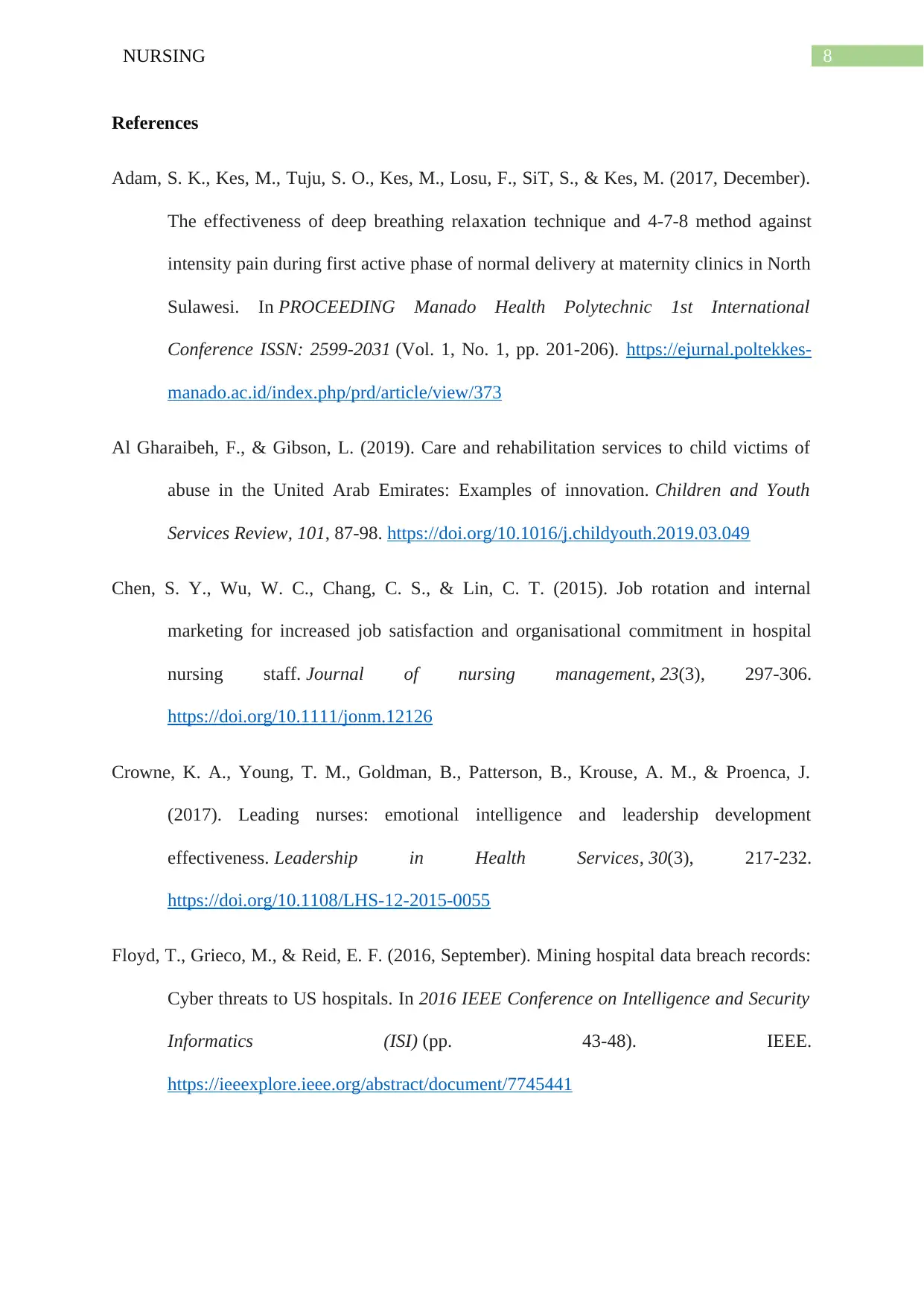
8NURSING
References
Adam, S. K., Kes, M., Tuju, S. O., Kes, M., Losu, F., SiT, S., & Kes, M. (2017, December).
The effectiveness of deep breathing relaxation technique and 4-7-8 method against
intensity pain during first active phase of normal delivery at maternity clinics in North
Sulawesi. In PROCEEDING Manado Health Polytechnic 1st International
Conference ISSN: 2599-2031 (Vol. 1, No. 1, pp. 201-206). https://ejurnal.poltekkes-
manado.ac.id/index.php/prd/article/view/373
Al Gharaibeh, F., & Gibson, L. (2019). Care and rehabilitation services to child victims of
abuse in the United Arab Emirates: Examples of innovation. Children and Youth
Services Review, 101, 87-98. https://doi.org/10.1016/j.childyouth.2019.03.049
Chen, S. Y., Wu, W. C., Chang, C. S., & Lin, C. T. (2015). Job rotation and internal
marketing for increased job satisfaction and organisational commitment in hospital
nursing staff. Journal of nursing management, 23(3), 297-306.
https://doi.org/10.1111/jonm.12126
Crowne, K. A., Young, T. M., Goldman, B., Patterson, B., Krouse, A. M., & Proenca, J.
(2017). Leading nurses: emotional intelligence and leadership development
effectiveness. Leadership in Health Services, 30(3), 217-232.
https://doi.org/10.1108/LHS-12-2015-0055
Floyd, T., Grieco, M., & Reid, E. F. (2016, September). Mining hospital data breach records:
Cyber threats to US hospitals. In 2016 IEEE Conference on Intelligence and Security
Informatics (ISI) (pp. 43-48). IEEE.
https://ieeexplore.ieee.org/abstract/document/7745441
References
Adam, S. K., Kes, M., Tuju, S. O., Kes, M., Losu, F., SiT, S., & Kes, M. (2017, December).
The effectiveness of deep breathing relaxation technique and 4-7-8 method against
intensity pain during first active phase of normal delivery at maternity clinics in North
Sulawesi. In PROCEEDING Manado Health Polytechnic 1st International
Conference ISSN: 2599-2031 (Vol. 1, No. 1, pp. 201-206). https://ejurnal.poltekkes-
manado.ac.id/index.php/prd/article/view/373
Al Gharaibeh, F., & Gibson, L. (2019). Care and rehabilitation services to child victims of
abuse in the United Arab Emirates: Examples of innovation. Children and Youth
Services Review, 101, 87-98. https://doi.org/10.1016/j.childyouth.2019.03.049
Chen, S. Y., Wu, W. C., Chang, C. S., & Lin, C. T. (2015). Job rotation and internal
marketing for increased job satisfaction and organisational commitment in hospital
nursing staff. Journal of nursing management, 23(3), 297-306.
https://doi.org/10.1111/jonm.12126
Crowne, K. A., Young, T. M., Goldman, B., Patterson, B., Krouse, A. M., & Proenca, J.
(2017). Leading nurses: emotional intelligence and leadership development
effectiveness. Leadership in Health Services, 30(3), 217-232.
https://doi.org/10.1108/LHS-12-2015-0055
Floyd, T., Grieco, M., & Reid, E. F. (2016, September). Mining hospital data breach records:
Cyber threats to US hospitals. In 2016 IEEE Conference on Intelligence and Security
Informatics (ISI) (pp. 43-48). IEEE.
https://ieeexplore.ieee.org/abstract/document/7745441
⊘ This is a preview!⊘
Do you want full access?
Subscribe today to unlock all pages.

Trusted by 1+ million students worldwide
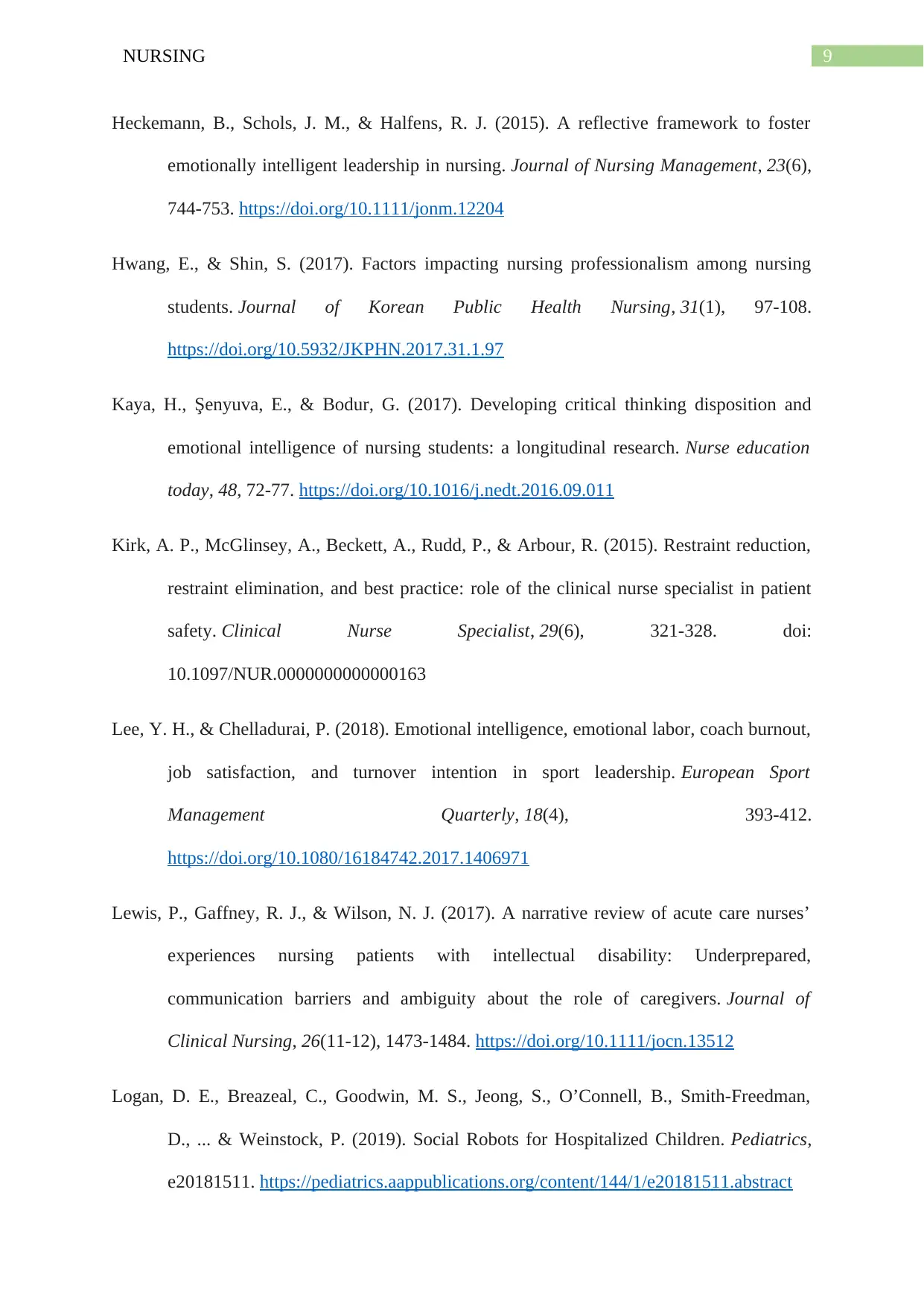
9NURSING
Heckemann, B., Schols, J. M., & Halfens, R. J. (2015). A reflective framework to foster
emotionally intelligent leadership in nursing. Journal of Nursing Management, 23(6),
744-753. https://doi.org/10.1111/jonm.12204
Hwang, E., & Shin, S. (2017). Factors impacting nursing professionalism among nursing
students. Journal of Korean Public Health Nursing, 31(1), 97-108.
https://doi.org/10.5932/JKPHN.2017.31.1.97
Kaya, H., Şenyuva, E., & Bodur, G. (2017). Developing critical thinking disposition and
emotional intelligence of nursing students: a longitudinal research. Nurse education
today, 48, 72-77. https://doi.org/10.1016/j.nedt.2016.09.011
Kirk, A. P., McGlinsey, A., Beckett, A., Rudd, P., & Arbour, R. (2015). Restraint reduction,
restraint elimination, and best practice: role of the clinical nurse specialist in patient
safety. Clinical Nurse Specialist, 29(6), 321-328. doi:
10.1097/NUR.0000000000000163
Lee, Y. H., & Chelladurai, P. (2018). Emotional intelligence, emotional labor, coach burnout,
job satisfaction, and turnover intention in sport leadership. European Sport
Management Quarterly, 18(4), 393-412.
https://doi.org/10.1080/16184742.2017.1406971
Lewis, P., Gaffney, R. J., & Wilson, N. J. (2017). A narrative review of acute care nurses’
experiences nursing patients with intellectual disability: Underprepared,
communication barriers and ambiguity about the role of caregivers. Journal of
Clinical Nursing, 26(11-12), 1473-1484. https://doi.org/10.1111/jocn.13512
Logan, D. E., Breazeal, C., Goodwin, M. S., Jeong, S., O’Connell, B., Smith-Freedman,
D., ... & Weinstock, P. (2019). Social Robots for Hospitalized Children. Pediatrics,
e20181511. https://pediatrics.aappublications.org/content/144/1/e20181511.abstract
Heckemann, B., Schols, J. M., & Halfens, R. J. (2015). A reflective framework to foster
emotionally intelligent leadership in nursing. Journal of Nursing Management, 23(6),
744-753. https://doi.org/10.1111/jonm.12204
Hwang, E., & Shin, S. (2017). Factors impacting nursing professionalism among nursing
students. Journal of Korean Public Health Nursing, 31(1), 97-108.
https://doi.org/10.5932/JKPHN.2017.31.1.97
Kaya, H., Şenyuva, E., & Bodur, G. (2017). Developing critical thinking disposition and
emotional intelligence of nursing students: a longitudinal research. Nurse education
today, 48, 72-77. https://doi.org/10.1016/j.nedt.2016.09.011
Kirk, A. P., McGlinsey, A., Beckett, A., Rudd, P., & Arbour, R. (2015). Restraint reduction,
restraint elimination, and best practice: role of the clinical nurse specialist in patient
safety. Clinical Nurse Specialist, 29(6), 321-328. doi:
10.1097/NUR.0000000000000163
Lee, Y. H., & Chelladurai, P. (2018). Emotional intelligence, emotional labor, coach burnout,
job satisfaction, and turnover intention in sport leadership. European Sport
Management Quarterly, 18(4), 393-412.
https://doi.org/10.1080/16184742.2017.1406971
Lewis, P., Gaffney, R. J., & Wilson, N. J. (2017). A narrative review of acute care nurses’
experiences nursing patients with intellectual disability: Underprepared,
communication barriers and ambiguity about the role of caregivers. Journal of
Clinical Nursing, 26(11-12), 1473-1484. https://doi.org/10.1111/jocn.13512
Logan, D. E., Breazeal, C., Goodwin, M. S., Jeong, S., O’Connell, B., Smith-Freedman,
D., ... & Weinstock, P. (2019). Social Robots for Hospitalized Children. Pediatrics,
e20181511. https://pediatrics.aappublications.org/content/144/1/e20181511.abstract
Paraphrase This Document
Need a fresh take? Get an instant paraphrase of this document with our AI Paraphraser
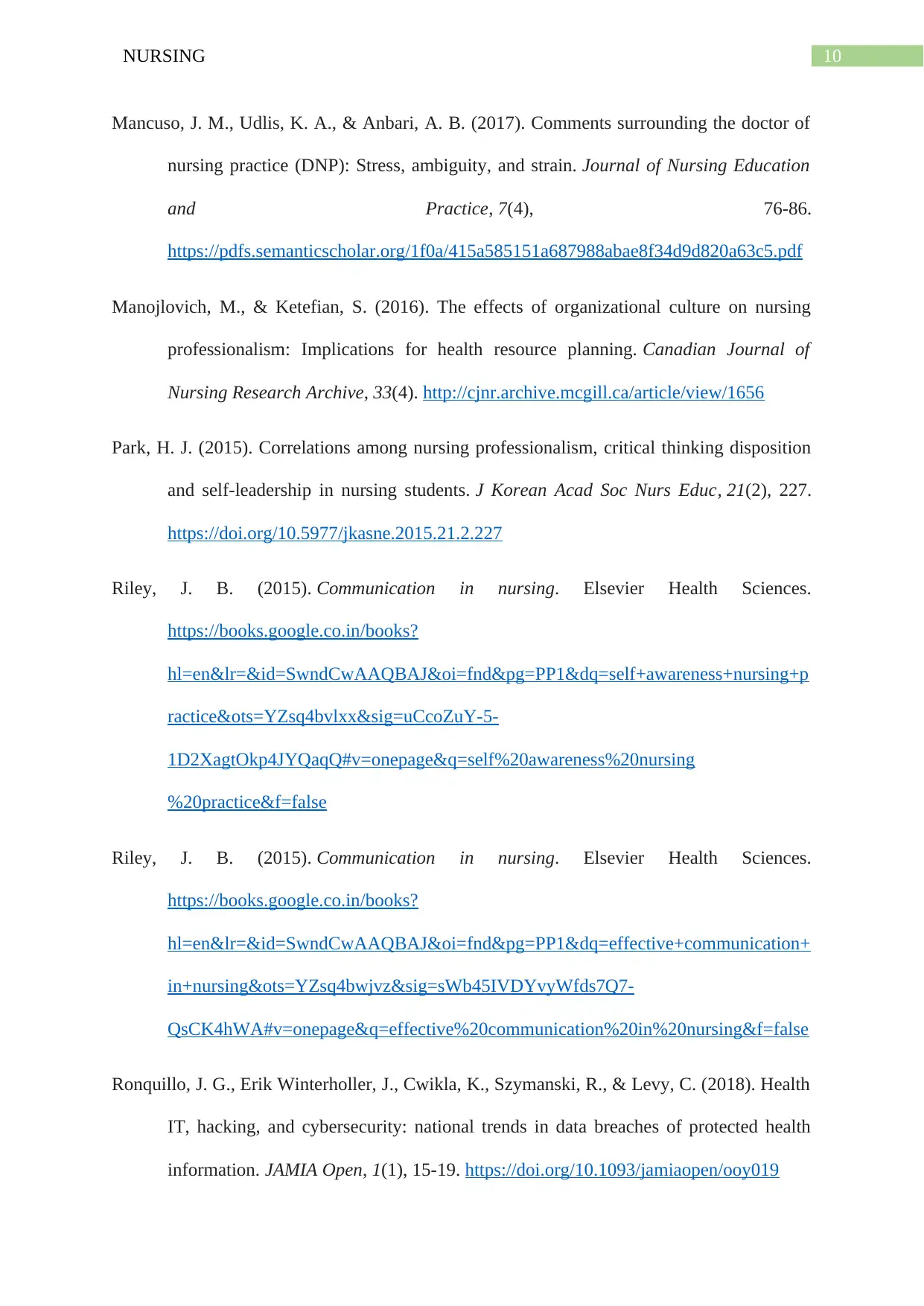
10NURSING
Mancuso, J. M., Udlis, K. A., & Anbari, A. B. (2017). Comments surrounding the doctor of
nursing practice (DNP): Stress, ambiguity, and strain. Journal of Nursing Education
and Practice, 7(4), 76-86.
https://pdfs.semanticscholar.org/1f0a/415a585151a687988abae8f34d9d820a63c5.pdf
Manojlovich, M., & Ketefian, S. (2016). The effects of organizational culture on nursing
professionalism: Implications for health resource planning. Canadian Journal of
Nursing Research Archive, 33(4). http://cjnr.archive.mcgill.ca/article/view/1656
Park, H. J. (2015). Correlations among nursing professionalism, critical thinking disposition
and self-leadership in nursing students. J Korean Acad Soc Nurs Educ, 21(2), 227.
https://doi.org/10.5977/jkasne.2015.21.2.227
Riley, J. B. (2015). Communication in nursing. Elsevier Health Sciences.
https://books.google.co.in/books?
hl=en&lr=&id=SwndCwAAQBAJ&oi=fnd&pg=PP1&dq=self+awareness+nursing+p
ractice&ots=YZsq4bvlxx&sig=uCcoZuY-5-
1D2XagtOkp4JYQaqQ#v=onepage&q=self%20awareness%20nursing
%20practice&f=false
Riley, J. B. (2015). Communication in nursing. Elsevier Health Sciences.
https://books.google.co.in/books?
hl=en&lr=&id=SwndCwAAQBAJ&oi=fnd&pg=PP1&dq=effective+communication+
in+nursing&ots=YZsq4bwjvz&sig=sWb45IVDYvyWfds7Q7-
QsCK4hWA#v=onepage&q=effective%20communication%20in%20nursing&f=false
Ronquillo, J. G., Erik Winterholler, J., Cwikla, K., Szymanski, R., & Levy, C. (2018). Health
IT, hacking, and cybersecurity: national trends in data breaches of protected health
information. JAMIA Open, 1(1), 15-19. https://doi.org/10.1093/jamiaopen/ooy019
Mancuso, J. M., Udlis, K. A., & Anbari, A. B. (2017). Comments surrounding the doctor of
nursing practice (DNP): Stress, ambiguity, and strain. Journal of Nursing Education
and Practice, 7(4), 76-86.
https://pdfs.semanticscholar.org/1f0a/415a585151a687988abae8f34d9d820a63c5.pdf
Manojlovich, M., & Ketefian, S. (2016). The effects of organizational culture on nursing
professionalism: Implications for health resource planning. Canadian Journal of
Nursing Research Archive, 33(4). http://cjnr.archive.mcgill.ca/article/view/1656
Park, H. J. (2015). Correlations among nursing professionalism, critical thinking disposition
and self-leadership in nursing students. J Korean Acad Soc Nurs Educ, 21(2), 227.
https://doi.org/10.5977/jkasne.2015.21.2.227
Riley, J. B. (2015). Communication in nursing. Elsevier Health Sciences.
https://books.google.co.in/books?
hl=en&lr=&id=SwndCwAAQBAJ&oi=fnd&pg=PP1&dq=self+awareness+nursing+p
ractice&ots=YZsq4bvlxx&sig=uCcoZuY-5-
1D2XagtOkp4JYQaqQ#v=onepage&q=self%20awareness%20nursing
%20practice&f=false
Riley, J. B. (2015). Communication in nursing. Elsevier Health Sciences.
https://books.google.co.in/books?
hl=en&lr=&id=SwndCwAAQBAJ&oi=fnd&pg=PP1&dq=effective+communication+
in+nursing&ots=YZsq4bwjvz&sig=sWb45IVDYvyWfds7Q7-
QsCK4hWA#v=onepage&q=effective%20communication%20in%20nursing&f=false
Ronquillo, J. G., Erik Winterholler, J., Cwikla, K., Szymanski, R., & Levy, C. (2018). Health
IT, hacking, and cybersecurity: national trends in data breaches of protected health
information. JAMIA Open, 1(1), 15-19. https://doi.org/10.1093/jamiaopen/ooy019
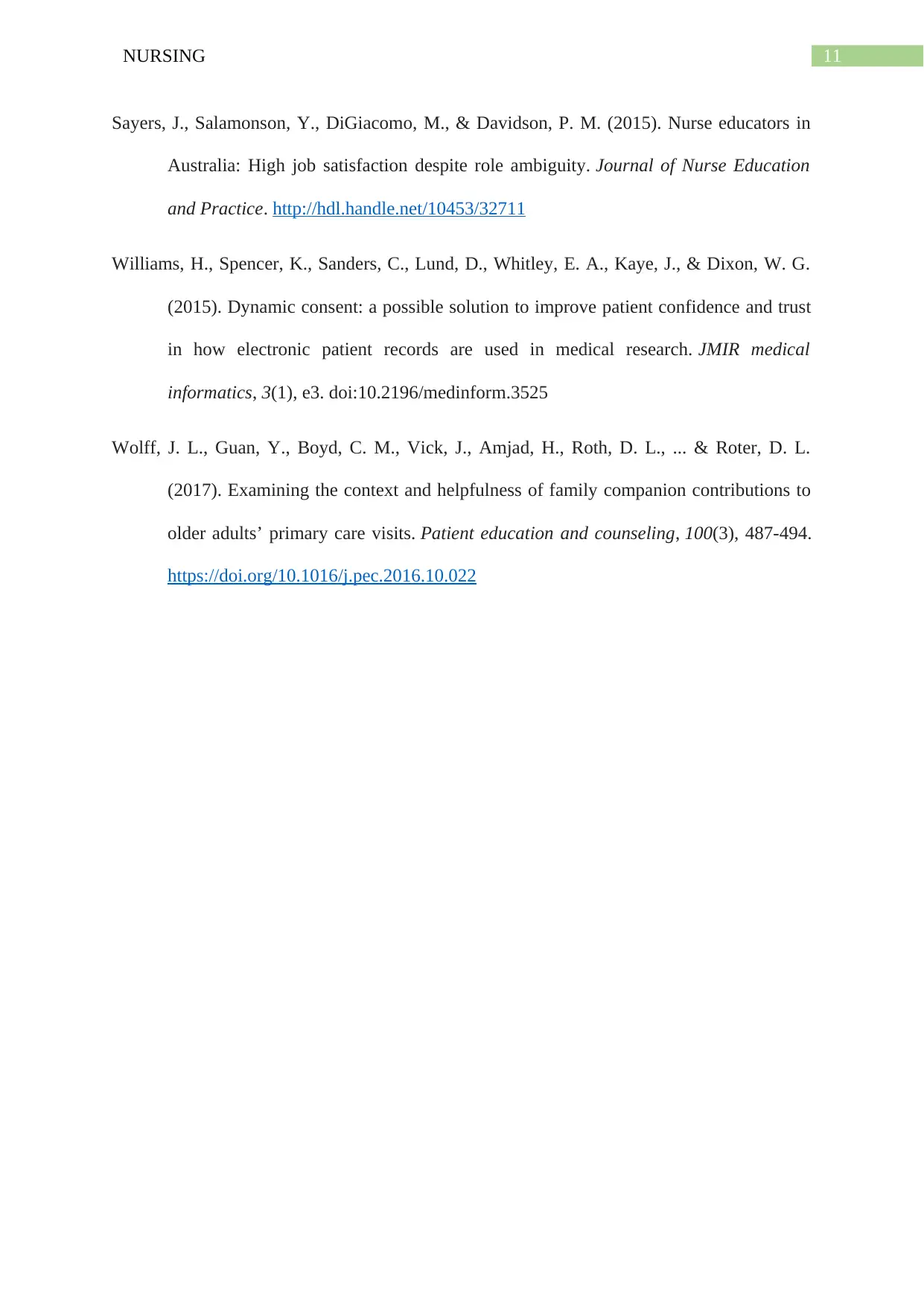
11NURSING
Sayers, J., Salamonson, Y., DiGiacomo, M., & Davidson, P. M. (2015). Nurse educators in
Australia: High job satisfaction despite role ambiguity. Journal of Nurse Education
and Practice. http://hdl.handle.net/10453/32711
Williams, H., Spencer, K., Sanders, C., Lund, D., Whitley, E. A., Kaye, J., & Dixon, W. G.
(2015). Dynamic consent: a possible solution to improve patient confidence and trust
in how electronic patient records are used in medical research. JMIR medical
informatics, 3(1), e3. doi:10.2196/medinform.3525
Wolff, J. L., Guan, Y., Boyd, C. M., Vick, J., Amjad, H., Roth, D. L., ... & Roter, D. L.
(2017). Examining the context and helpfulness of family companion contributions to
older adults’ primary care visits. Patient education and counseling, 100(3), 487-494.
https://doi.org/10.1016/j.pec.2016.10.022
Sayers, J., Salamonson, Y., DiGiacomo, M., & Davidson, P. M. (2015). Nurse educators in
Australia: High job satisfaction despite role ambiguity. Journal of Nurse Education
and Practice. http://hdl.handle.net/10453/32711
Williams, H., Spencer, K., Sanders, C., Lund, D., Whitley, E. A., Kaye, J., & Dixon, W. G.
(2015). Dynamic consent: a possible solution to improve patient confidence and trust
in how electronic patient records are used in medical research. JMIR medical
informatics, 3(1), e3. doi:10.2196/medinform.3525
Wolff, J. L., Guan, Y., Boyd, C. M., Vick, J., Amjad, H., Roth, D. L., ... & Roter, D. L.
(2017). Examining the context and helpfulness of family companion contributions to
older adults’ primary care visits. Patient education and counseling, 100(3), 487-494.
https://doi.org/10.1016/j.pec.2016.10.022
⊘ This is a preview!⊘
Do you want full access?
Subscribe today to unlock all pages.

Trusted by 1+ million students worldwide
1 out of 12
Related Documents
Your All-in-One AI-Powered Toolkit for Academic Success.
+13062052269
info@desklib.com
Available 24*7 on WhatsApp / Email
![[object Object]](/_next/static/media/star-bottom.7253800d.svg)
Unlock your academic potential
Copyright © 2020–2025 A2Z Services. All Rights Reserved. Developed and managed by ZUCOL.





